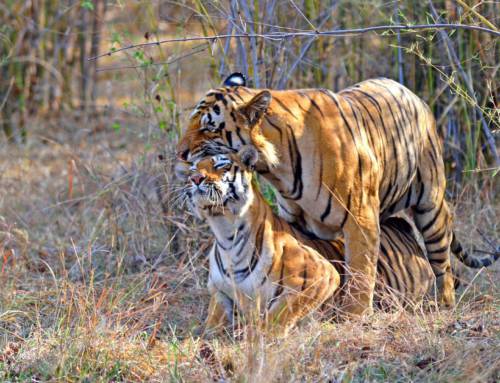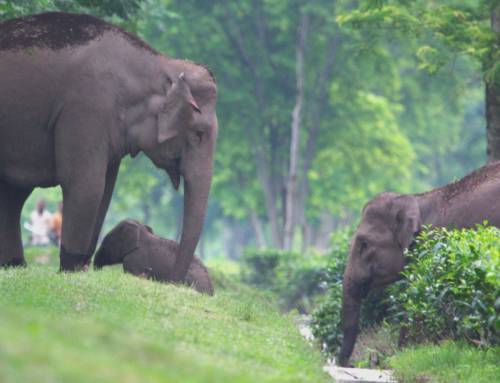Research Article: Karanth, K. U., Chundawat, R. S., Nichols, J. D., & Kumar, N. S. (2004). Estimation of tiger densities in the tropical dry forests of Panna, Central India, using photographic capture–recapture sampling. Animal Conservation, 7(3), 285–290.
Blog author: Aishwarya Laghate
Key Takeaways:
- The study estimated that about 7 tigers are living in every 100 square kilometers of the Panna Tiger Reserve, using photographic capture-recapture techniques.
- This number depends largely on the amount of food available— about 31 ungulates like deer and antelope per square kilometer are enough to support a healthy tiger population
- The study employed advanced methods to ensure the tiger count was accurate. These methods looked at how tigers react to cameras, how each tiger behaves differently, and how they move around in the forest.
- Researchers emphasized the potential of India’s 150,000 square kilometers of tropical dry forests to support up to 9,000 tigers, if effective anti-poaching measures, habitat restoration, and voluntary village relocations are implemented.
Forests in India are home to the highest number of tigers (Panthera tigris) in the world. Despite challenges to current conservation efforts like habitat fragmentation and human interference, protected areas and the high carrying capacity of tropical forests have helped ensure the survival of tigers. The study by Karanth et al. in the Panna Wildlife Reserve of Madhya Pradesh provides vital information on tiger numbers, the presence of prey, and the potential of tropical dry forests across India for future conservation efforts.
The Panna Tiger Reserve is spread across 542 square kilometers of tropical dry-deciduous forests in central India. This unique habitat is characterized by step-like plateaus, escarpments, and the Ken River, which flows through the reserve. Despite the presence of 14 villages and nearly 10,000 livestock, Panna’s conservation efforts have ensured a relatively undisturbed core area for wildlife. Apart from charismatic and emblematic species such as the tiger, Panna is habitat for large carnivores like Leopards and Sloth bears, and ungulate prey such as Sambar, Chital, and Nilgai.
Researchers employed a rigorous photographic capture-recapture method to estimate tiger populations. Using 20 Trailmaster™ camera traps distributed across 60 sites, the study was conducted over 45 days, yielding 914 trap days of effort. Each tiger photographed was uniquely identified by its stripe pattern. Data from these photos allowed researchers to construct capture histories and analyse population dynamics using advanced statistical models.
The study revealed a tiger density of 6.94 individuals per 100 square kilometres in the Panna study area. While lower than Ranthambore’s density of 11.46 tigers per 100 square kilometres, this is a remarkable figure given Panna’s shorter history of protection. Prey biomass density was estimated at 3,117 kg per square kilometre, supporting predictions of higher tiger density based on prey availability. This highlights the critical relationship between prey abundance and predator populations. The researchers also estimated a population of 29 tigers in the sampled area, emphasizing the importance of robust statistical methods to account for undetected individuals.
The findings highlight the potential of tropical dry forests to enhance tiger populations. With an estimated 150,000 square kilometers of such forests remaining in India, there is room for significant population recovery. However, higher numbers will require renewed conservation efforts such as enhanced anti-poaching patrols, reduced livestock grazing and biomass removal, relocation of human settlements from critical habitats, rigorous monitoring, and adaptive management strategies.
This study reaffirms the effectiveness of camera-trap surveys for estimating tiger densities. However, as these surveys become more common worldwide, there is a need for better design and analysis protocols to maximize their utility. Improved methodologies can lead to more accurate assessments and actionable conservation efforts.
The study’s results from a conservation standpoint are positive and offer hope for restoring tiger populations in India’s dry forests. By implementing targeted conservation actions and replicating Panna’s success across other wildlife reserves, India could potentially support up to 9,000 tigers in these habitats. The road ahead demands collaboration, dedication, and the integration of science-based approaches to ensure a thriving future for one of the world’s most iconic species.
To access the original article, click here.
Keywords: Tiger Conservation, Carnivore Ecology, Tiger Density Estimation, Habitat Restoration, Conservation Strategies




